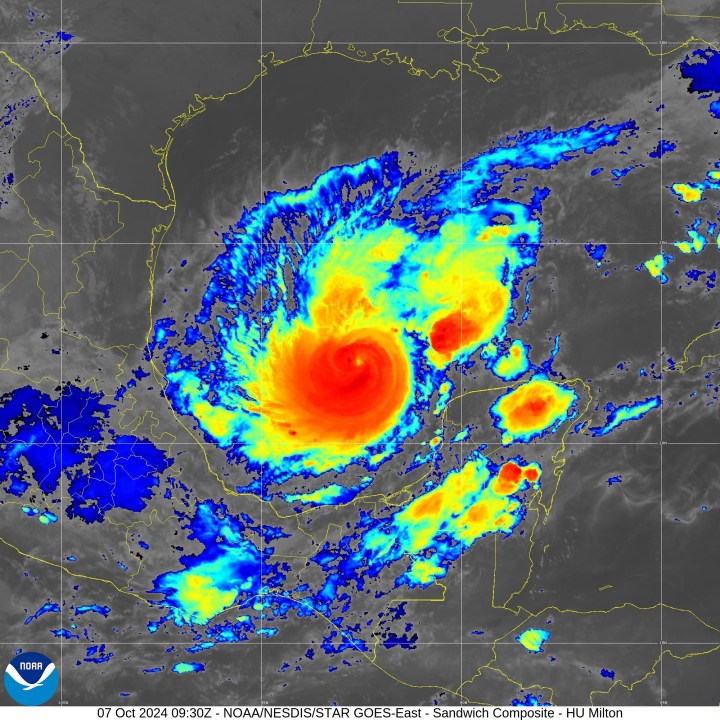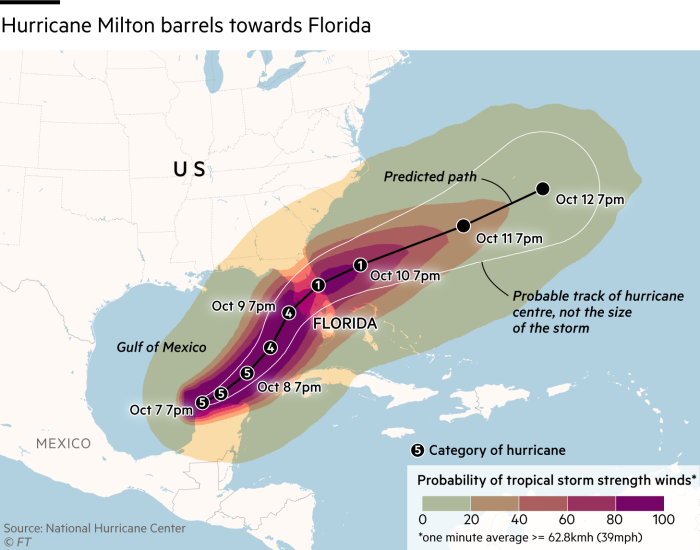Hurricane Milton Live Updates: Latest Storm Forecasts, Maps, and Imagery
Hurricane Milton Live Updates: Latest Storm Forecasts, Maps, and Imagery
As Hurricane Milton continues its march toward the coastline, it has become a significant concern for millions of residents across its projected path. With rapid intensification over the warm waters of the Atlantic, Milton has evolved into a formidable Category 4 storm, boasting sustained winds of over 130 miles per hour. This article will provide you with the latest live updates, storm forecasts, real-time maps, and imagery to help you stay informed and prepared.
Current Status of Hurricane Milton
As of the latest advisory from the National Hurricane Center (NHC), Hurricane Milton is centered approximately 200 miles east of the southeastern U.S. coastline, moving northwest at 15 mph. The storm’s powerful winds and heavy rains are already impacting offshore areas, with conditions expected to deteriorate along the coast over the next 24-48 hours.

Milton’s pressure continues to drop, a clear sign of further strengthening. Forecasters warn that the storm could reach Category 5 status before making landfall, which could result in catastrophic damage along its projected path.
Live Updates
- October 9, 2024, 10 AM ET: The NHC has issued hurricane warnings for coastal regions stretching from northern Florida to southern North Carolina. Evacuation orders are in place for low-lying and flood-prone areas.
- October 9, 2024, 1 PM ET: The outer bands of Milton are beginning to lash the Florida coastline with heavy rain and tropical storm-force winds. Officials urge residents to complete their storm preparations and shelter in place.
- October 9, 2024, 4 PM ET: Several airlines have announced flight cancellations for airports in the storm’s path, including Jacksonville, Savannah, and Charleston. Power companies are staging crews to respond to anticipated widespread outages.
Latest Storm Forecast
The latest storm track has Milton continuing on its northwestern trajectory, with landfall expected in the early hours of October 10, likely along the coasts of Georgia or South Carolina. There is some uncertainty in the exact landfall location, but models suggest the storm could impact major population centers such as Savannah, Charleston, and even Wilmington.
The NHC is warning of several hazards:
Storm Surge: A life-threatening storm surge of 8-12 feet is expected along the coastline from northern Florida to southern North Carolina. Residents in these areas are urged to heed evacuation orders and avoid flooded areas.
Wind Damage: Hurricane-force winds are expected to extend outward up to 50 miles from the center, with tropical storm-force winds extending up to 200 miles. Buildings, trees, and power lines in the path of the storm are at risk of significant damage.
Heavy Rainfall: Milton is forecasted to drop 10-15 inches of rain, with isolated amounts of up to 20 inches in some areas. This will likely result in flash flooding, particularly in urban areas and regions with poor drainage systems.

Forecast Models
Meteorologists continue to rely on advanced weather models to predict Milton’s path and intensity. The European Model (ECMWF) and the Global Forecast System (GFS) are the two primary models used by forecasters, and both indicate a potential shift in the storm’s path to the north, meaning the Carolinas could bear the brunt of the storm.
While the exact landfall location remains uncertain, residents across the southeastern U.S. are advised to stay vigilant and monitor local forecasts for any changes in Milton’s trajectory.
Maps and Imagery
Thanks to advancements in satellite technology, real-time maps and imagery provide invaluable insights into Hurricane Milton’s progression. The NHC and NOAA are offering live satellite views of the storm, which can be accessed through their websites. These high-resolution images show the eye of the hurricane, the expansive cloud coverage, and the storm’s size, providing a sense of its power.
In addition to satellite imagery, radar data is available for areas already feeling the effects of Milton’s outer bands. This allows residents and emergency responders to track the storm’s rainfall and wind speeds in real time. For those in the storm’s direct path, real-time maps from various weather agencies can help pinpoint the storm’s location and determine when to expect the worst conditions.
Preparation Tips
With the storm rapidly approaching, it is crucial for those in Hurricane Milton’s path to take the following steps:
Evacuation: If local authorities have issued an evacuation order, leave immediately. Follow designated evacuation routes and avoid flooded roads.
Sheltering in Place: If you are unable to evacuate, find a safe location in your home, away from windows and exterior doors. Stock up on essential supplies, including non-perishable food, water, medications, and flashlights.
Communication: Stay informed by listening to weather updates on a battery-powered radio or through emergency apps. Let family members know your evacuation plans or where you will be sheltering.
Emergency Kit: Ensure you have a fully stocked emergency kit with enough supplies to last at least 72 hours. This includes water, food, first-aid supplies, important documents, and personal hygiene items.
Conclusion
Hurricane Milton is shaping up to be one of the most powerful storms of the season, and it is imperative that those in its path take the necessary precautions to stay safe. As the storm nears the southeastern U.S., staying informed through live updates, forecasts, and real-time maps will be critical for ensuring your safety. Continue to monitor local news, heed official warnings, and take all necessary actions to protect yourself, your family, and your property.
Stay tuned for further updates as Hurricane Milton approaches, and stay safe.